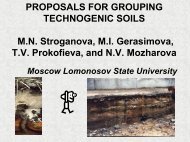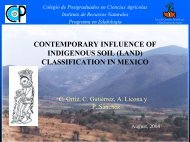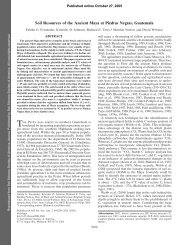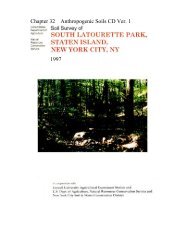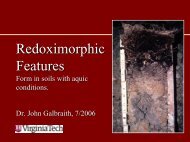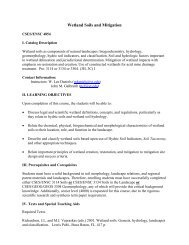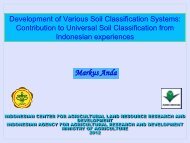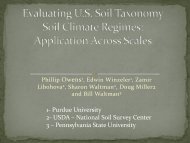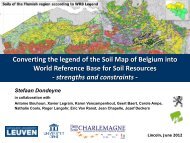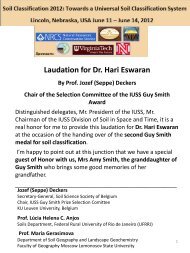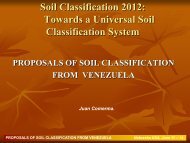Nebraska Soils Field Trip - Virginia Tech
Nebraska Soils Field Trip - Virginia Tech
Nebraska Soils Field Trip - Virginia Tech
Create successful ePaper yourself
Turn your PDF publications into a flip-book with our unique Google optimized e-Paper software.
4th IUSS Soil Classification Conference <strong>Field</strong> Tour Guidebook<br />
GEOGRAPHICALLY ASSOCIATED SOILS: These are the Butler, Geary, Judson,<br />
Mayberry, Pawnee and Yutan soils.<br />
Butler soils are somewhat poorly drained and form a drainage sequence with the Aksarben soils<br />
and commonly are in the swale parts of the landscape.<br />
Judson soils are on footslopes and formed in local colluvium.<br />
Mayberry soils are on adjoining lower parts of the landscape. They formed in till or in paleosols<br />
formed in till.<br />
Pawnee soils are on adjoining lower parts of the landscape. They formed in till or in paleosols<br />
formed in till.<br />
Yutan soils have mollic colors less than 10 inches thick, average less clay in the particle size<br />
control section and are on shoulders and backslopes.<br />
DRAINAGE AND SATURATED HYDRAULIC CONDUCTIVITY:<br />
Drainage: Well drained.<br />
Surface runoff: Low to moderately high.<br />
Saturated hydraulic conductivity: Moderately low<br />
USE AND VEGETATION: Most areas are cultivated.<br />
The main crops are corn, soybeans, small grains and grain sorghum.<br />
Native vegetation is tall prairie grasses.<br />
DISTRIBUTION AND EXTENT: Southeastern <strong>Nebraska</strong> and northeastern Kansas. LRR 5,<br />
MLRA 106. They are extensive.<br />
MLRA SOIL SURVEY REGIONAL OFFICE (MO) RESPONSIBLE: Salina, Kansas<br />
SERIES ESTABLISHED: Brown County, Kansas, 1994.<br />
REMARKS: Diagnostic horizons and features recognized in this pedon are:<br />
Particle-size control section: 30 to 80 centimeters. (Bt1, Bt2, and Bt3 horizons)<br />
Mollic epipedon: 0 to 46 centimeters. (Ap, A, and Bt1 horizons)<br />
Argillic horizon: 30 to 107 centimeters. (Bt1, Bt2, Bt3, and Bt4 horizons)<br />
Redoximorphic concentrations (relict): 46 to 203 centimeters. (Bt2, Bt3, Bt4, BC, and C<br />
horizons)<br />
Moisture regime: Udic<br />
These soils were previously mapped as Sharpsburg soils. The Sharpsburg soils are moderately<br />
well drained and have a perched water table at a depth of 1.2 to 1.8 meters.<br />
CL 6/30/2008 Removed the term mottling from the OSD and replaced with redox or<br />
redoximorphic features. All SE units were removed.<br />
National Cooperative Soil Survey<br />
U.S.A.<br />
54



